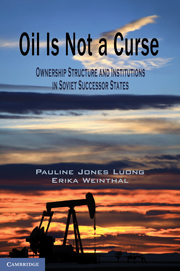Book contents
- Frontmatter
- Contents
- Tables
- Figures
- Maps
- 1 Rethinking the Resource Curse
- 2 Why Fiscal Regimes
- 3 State Ownership with Control versus Private Domestic Ownership
- 4 Two Versions of Rentierism
- 5 Petroleum Rents without Rentierism
- 6 State Ownership without Control versus Private Foreign Ownership
- 7 Eluding the Obsolescing Bargain
- 8 Revisiting the Obsolescing Bargain
- 9 Taking Domestic Politics Seriously
- 10 The Myth of the Resource Curse
- Appendix A List of Authors’ Interviews
- Appendix B Variation in Ownership Structure in Developing Countries
- Appendix C Responses to Select Life in Transition Survey (LiTS) Questions by Age Group
- Appendix D Ranking Basis for Determining which Countries are Included in Our Database
- Works Cited
- Index
8 - Revisiting the Obsolescing Bargain
Foreign Private Ownership in Kazakhstan
Published online by Cambridge University Press: 05 June 2012
- Frontmatter
- Contents
- Tables
- Figures
- Maps
- 1 Rethinking the Resource Curse
- 2 Why Fiscal Regimes
- 3 State Ownership with Control versus Private Domestic Ownership
- 4 Two Versions of Rentierism
- 5 Petroleum Rents without Rentierism
- 6 State Ownership without Control versus Private Foreign Ownership
- 7 Eluding the Obsolescing Bargain
- 8 Revisiting the Obsolescing Bargain
- 9 Taking Domestic Politics Seriously
- 10 The Myth of the Resource Curse
- Appendix A List of Authors’ Interviews
- Appendix B Variation in Ownership Structure in Developing Countries
- Appendix C Responses to Select Life in Transition Survey (LiTS) Questions by Age Group
- Appendix D Ranking Basis for Determining which Countries are Included in Our Database
- Works Cited
- Index
Summary
Russia makes western oil companies fret and fume. Kazakhstan, by comparison, makes them feel rather secure.
– Economist 1992If I had to describe the investment climate [in Kazakhstan] in one word it would be – unpredictable.
– FOC representative 2000 (Authors’ interview)The Kazakhs see the foreigners coming with boat loads of money that is easy cash and taxes for the government.
– USAID representative 2000 (Authors’ interview)In 1999, Kazakhstan marked the centennial of the first major oil gusher discovered on its territory – in Karashungul, Western Kazakhstan (Khusainov and Turkeeva 2003, Tasmagambetov 1999). The celebration that ensued in Atyrau region heralded Kazakhstan’s long history of indigenous petroleum exploration and production. In reality, however, by the end of the 1990s, Kazakhstan’s oil and gas industry no longer reflected its indigenous roots. Only a few years after its independence from Soviet rule, the country’s leadership chose to forge ahead with private foreign ownership (P2). By choosing to sell off the majority of shares (>50 percent) in its production, refining and export facilities to a large number of foreign investors (FIs) in the mid-1990s, Kazakhstan veered 180 degrees away from the ownership structure that it inherited from the Soviet Union – state ownership with control (S1). As a result, in the 1990s the dominance of foreign oil and gas companies in the development of its petroleum industry had to be reconciled with the mirage of “Kazakhstani Oil.”
That its leadership would agree to bequeath both ownership and control over its petroleum industry to foreign oil companies (hereafter, FOCs) took many observers by surprise. At first glance, it did not seem that this newly independent state, which possessed some of the most prized oil fields in the Soviet Union such as the gigantic Tengiz field, and an indigenous cadre of neftyaniki or oilmen, was in dire need of foreign investment. Moreover, oil production had begun to climb in the 1970s in Kazakhstan such that it ranked second only to Russia among the Soviet successor states, which sharply contrasted with Azerbaijan’s dwindling production after having peaked in 1941 (Raballand and Genté 2008, 10–11, Sagers 1994, 271). It was also well known that the Minister of Oil and Gas, Nurlan Balgimbayev, opposed the privatization plan introduced under Prime Minister Akezhan Kazhegeldin in 1995 (Peck 2004, 150). Yet, owing to the domestic constraints that Kazakhstan’s governing elites faced at independence (discussed in Chapter 9), they were unable either to retain S1 or to adopt state ownership without control (S2), and instead, opted to pursue what is arguably the least preferred ownership structure from the state’s perspective – private foreign ownership (P2).
- Type
- Chapter
- Information
- Oil Is Not a CurseOwnership Structure and Institutions in Soviet Successor States, pp. 259 - 298Publisher: Cambridge University PressPrint publication year: 2010



